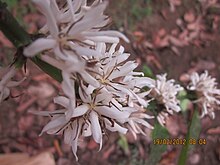Coffea This article is about the biology of coffe
Post# of 63897

Coffea
| ||||||||||||||||||||||||||||||
Coffea is a genus of flowering plants whose seeds , called coffee beans , are used to make coffee . It is a member of the Rubiaceae family . They are shrubs or small trees native to tropical and southern Africa and tropical Asia . Coffee ranks as one of the world's most valuable and widely traded commodity crops and is an important export product of several countries.
Contents |
Cultivation and use
Several species of Coffea may be grown for the beans. Coffea arabica accounts for 75-80 percent of the world's coffee production, while Coffea canephora accounts for about 20 percent. [ 1 ]
The trees produce red or purple fruits called "cherries" that look like drupes , but are epigynous berries . The cherries contain two seeds, the so-called "coffee beans", which — despite their name — are not true beans . In about 5-10% of any crop of coffee cherries, only a single bean, rather than the usual two, is found. This is called a peaberry , which is smaller and rounder than a normal coffee bean . It is often removed from the yield and either sold separately (as in New Guinea peaberry), or discarded.
When grown in the tropics, coffee is a vigorous bush or small tree that usually grows to a height of 3–3.5 m (10–12 feet). Most commonly cultivated coffee species grow best at high elevations, but are nevertheless intolerant of freezing temperatures. [ citation needed ]
The tree of Coffea arabica will grow fruits after three to five years, and will produce for about 50 to 60 years (although up to 100 years is possible). [ citation needed ] The white flowers are highly scented. The fruit takes about 9 months to ripen.
Ecology
The caffeine in coffee "beans" is a natural plant defense against herbivory , i.e. a toxic substance that protects the seeds of the plant.
Several insect pests affect coffee production, including the coffee borer beetle ( Hypothenemus hampei ) and the coffee leafminer ( Leucoptera caffeina ).
Coffee is used as a food plant by the larvae of some Lepidoptera ( butterfly and moth ) species, including napoleon jacutin ( Dalcera abrasa ), turnip moth and some members of the genus Endoclita , including E. damor and E. malabaricus .
Research
In 2008 and 2009, researchers from the Royal Botanic Gardens, Kew named seven species of Coffea from the mountains of northern Madagascar , including C. ambongensis , C. boinensis , C. labatii , C. pterocarpa , C. bissetiae, and C. namorokensis. [ 2 ]
In 2008, two new species of coffee plants were discovered in Cameroon : Coffea charrieriana , which is caffeine-free, and Coffea anthonyi . [ 3 ] By crossing the new species with other known coffees, two new features might be introduced to cultivated coffee plants: beans without caffeine and self-pollination .
 (0)
(0) (0)
(0)


